Summer is just around the corner, and many homesteaders are trying to decide what to plant on the homestead. As homesteaders, we tend to spend a lot of time outdoors, but in the summertime, we spend even more.
Deciding which summer plants to grow on your homestead can take some time and thought. Before you decide what to grow, you’ll want to ask yourself some important questions.
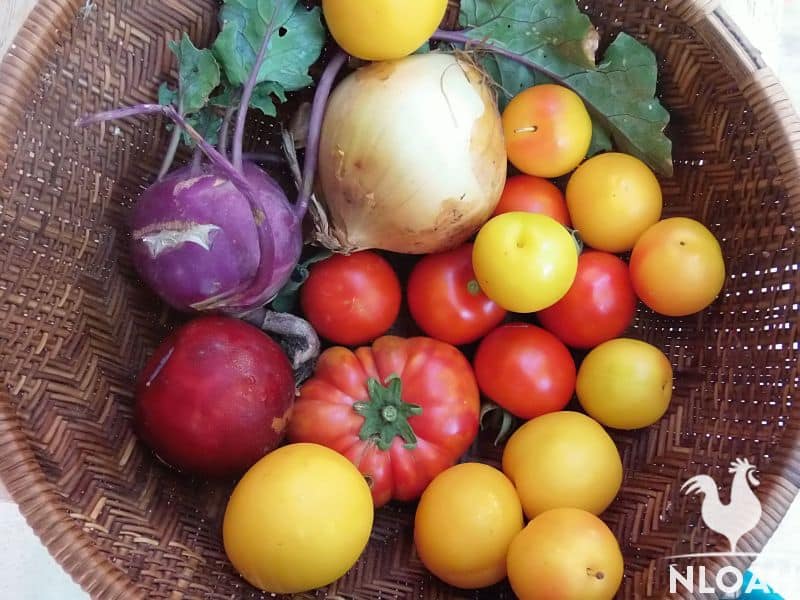
There are no right or wrong answers. Just be brutally honest with yourself, and focus on what truly matters to you and your homesteading family.
Will you be providing most of your food from the garden? Or will you simply be supplementing your regular diet?
If you’re going to be growing most if not all of your own groceries, make sure to include plenty of fresh fruits and vegetables in your list of list of summer plants. Flowers can take a backseat in this case.
Make sure that you’re well prepared and have plenty to can, freeze, dehydrate, and eat throughout the entire year if you rely on your own garden for as much of your food as possible.
Are you simply beautifying your homestead? Or will your plants have a purpose?
If you’re goal is to simply beautify your homestead, you can forgo many of the fruits and vegetables in the list of potential plants, although, on a homestead, most are seeking plenty of them to help make it through the winter months with a small grocery bill.
Many plants are both edible and pretty to look at. You’ll have many great options to consider if you choose to go for functionality and beauty combined. Many flowers are also edible, and you’ll find that you can combine many of them into your cooking as well.
Now that you’ve answered these important questions, you’re ready to decide which plants you’ll be planting for the summer on your homestead. Here are some great summer plants to grow on your homestead for a variety of reasons.
Flowers and Pollination
It’s important to understand that plants, just as humans, have both male and female parts. In plants these are called anthers and stigma. When the pollen is moved from the anther to the stigma, the plant is being pollinated.
This is an important step to ensure that your plants will give you flowers. Additionally, your fruit and vegetable plants will produce when they are properly pollinated. This is how plants are fertilized and begin production.
Proper pollination is essential to a healthy summer garden on the homestead. Flowers can serve multiple purposes, from looking pretty, to adding them to salads, pollination, and companion planting.
There are many great ways to incorporate flowers in and around your homestead to ensure that the bees are stopping by and pollinating the rest of your summer plants.
Keep in mind that bees prefer contrasting colors as well as blues, yellows, and white. They prefer mildly to moderately scented flowers.
If you have a homesteading member who is allergic to bees, plan accordingly. You may wish to plant bee attracting flowers at the edges of the homestead in order to reduce the chance of stings.
If bees feel welcome and that there are ample food sources, they will likely build a nest. Many homesteaders also raise bees (and this might be a great addition to your homestead) if you have an area that could support bee hives.
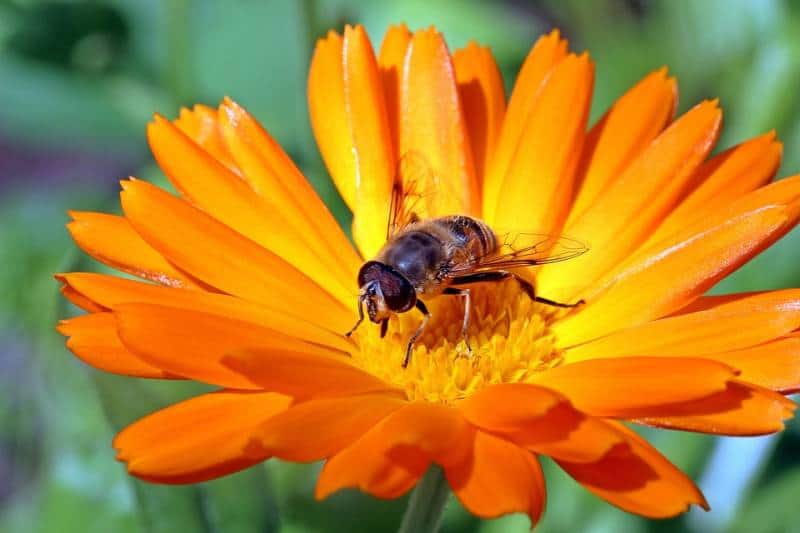
Marigolds
Marigolds are perfect for beginning gardeners looking for low-maintenance options. In fact, they’re practically foolproof. Just make sure you hold off on planting the seeds until after the final spring frost. A moist, well-draining soil is preferred.
Sunflowers (all heights)
The humble sunflower is the perfect choice for the beginning gardener. It requires minimal fertilizing and can survive in even the poorest soils.
It can handle a drought with ease, too. Sunflowers require a lot of sun, so just keep that in mind – and remember that growing sunflowers is a fantastic way to attract pollinators, too.
Zinnias
Zinnias grow quickly and bloom easily, too. You’ll get a ton of blooms without a ton of foliage, so you won’t feel like you need to fill up the rest of your garden once these flowers open, either. Plus, they attract butterflies!
You can readily pick and choose from this list or find other flowers that you enjoy. Flowers don’t just beautify your homestead, they’re also very beneficial.
Don’t forget that you can also take advantage of companion planting. Companion planting helps to reduce bugs and other issues that may affect the quality or integrity of your crops. Many plants thrive when you plant them near their favorite companions.
Vegetables
If you’re planning an edible garden on your homestead, you’ll want to plant what your family enjoys eating. You’ll have to determine how much to plant of each of your favorite vegetables.
Excess vegetables are frequently canned, frozen, and dehydrated for consumption later in the year. Root vegetables such as potatoes, carrots, and squashes are frequently placed into a root cellar as cold storage until such a time as they are brought to the dinner table.
Here are some of the top summer garden plants that most homesteaders enjoy throughout the summer months and well into the fall.
Leafy Greens
There aren’t many vegetables that are easier to grow than leafy greens! Whether it’s kale, spinach, or lettuce that have your heart, you can grow just about any kind of leafy green with minimal gardening know-how.
Many of these even grow well indoors or in containers! Plus, most leafy greens germinate and are mature quite quickly, so they’re a good option for impatient gardeners.
Cabbage
Cabbage is technically a leafy green, but I mention it separately because it’s also a cruciferous vegetable. It’s a lot easier to grow than you might expect.
As long as you keep certain pests – like cabbageworms – away with techniques like rotational and companion planting, there is very little you will need to do to care for these plants.
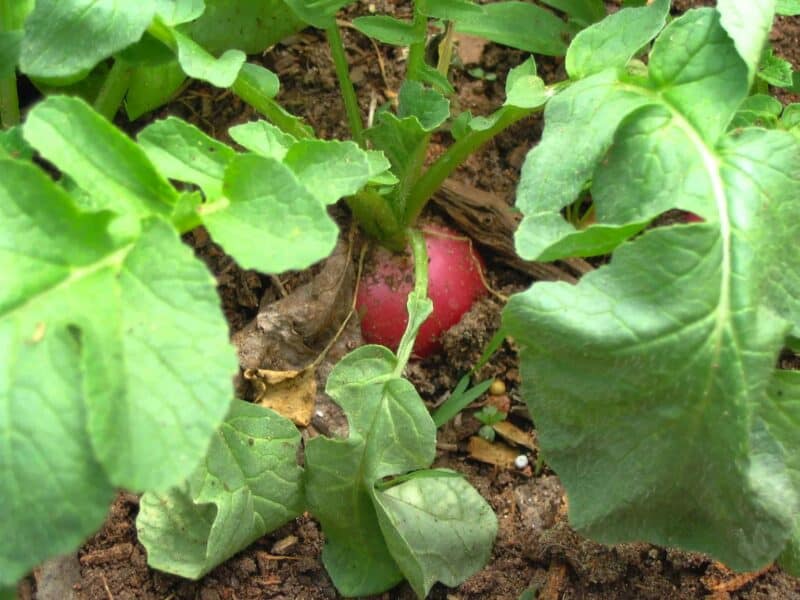
Radishes
Personally, I love growing radishes because they mature quickly and it doesn’t take a lot of work to get them from seed to dinner table. As long as you provide plenty of water (this helps prevent them from becoming woody), you don’t need to do very much to care for these tiny tubers.
Broccoli
The beauty of growing broccoli is that it can be cultivated at times of the year that aren’t quite as ideal for other types of plants.
This cold-hardy vegetable (along with its close cousin, cauliflower) can both be grown before the last expected frost, and long after you get your first frost in the fall, too.
If you are growing in a warm climate, just make sure you sow your seeds at the end of the summer for a fall or winter harvest, instead of planting in the heat of the summer.
Winter Squash
Winter squash germinates quickly and, with just a few seeds, you’ll get enough squash to last you in cold storage for the entire year. You don’t have to do much to preserve it – all you need is a cool cellar and your squash will last until the following spring.
Just make sure you cure it in the sun before storing it – but otherwise, no canning or freezing are required.
Pumpkin
Quit spending all of your money at the pumpkin patch in the fall! Instead, grow your own pumpkins. It’s easier than you think.
They require fertile, well-draining soil, but will mostly choke out the weeds once they get established. They also tend to keep mammalian pests out of the garden with their spiny leaves and stem so they can hep out other plants, too.
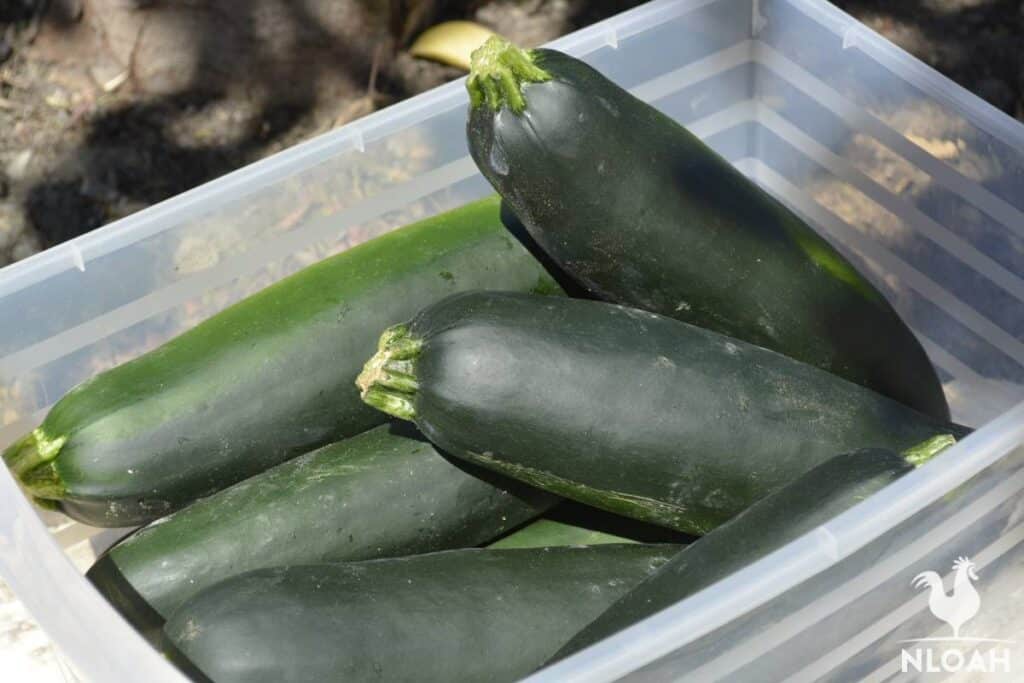
Zucchini
Zucchini is one of those garden vegetables that you either love or you hate. After all, just one zucchini plant produces a TON of fruit (probably more than you ever know what to do with).
That’s why most gardeners find themselves on their neighbors’ doorsteps at the height of the zucchini harvest in July, weighted down with “gifts” of extra zucchini.
Peas
As long as you start them early enough in the spring, peas are super-easy to grow. Regardless of the type – snow, sweet, or shelling – peas grow quickly and will produce just as often as you harvest them.
Beets
Beets don’t take vary long to mature – just a few weeks, in most cases. Plus, you can eat the greens, making or a versatile crop that is also easy to grow. As long as your soil is loose and fertile, you’ll have everything you need for a successful harvest of beets.
Carrots
Growing carrots is easy as long as you keep a few things in mind. First, make sure you plant in the cool part of the growing season (the spring for colder growing seasons and the fall for warmer ones).
They also need to be planted in soil that is loose and sandy. If there are too many rocks or heavy, compacted dirt in the way, the carrots may become forked or otherwise stunted.
Potatoes
Potatoes store well without any extra processing and when you’re growing spuds, you don’t have to worry about planting seeds. All you have to do is find a tuber that’s grown a few eyes.
Cut the potato up into chunks, with at least one eye on each chunk. That’s all there is to it! Potatoes are so easy to grow, some people even grow them in trash bags or containers, too.
Onions
Like the potato, the onion is a root crop that requires very little care. Plant them in the early spring and you’ll enjoy a harvest at the end of summer. If you’re impatient, you can harvest the miniature onions, too.
Peppers
Peppers are easy to grow. All you need to supply this plant with is fertile soil and a warm environment. To make your life even easier, plant your peppers in thick black plastic. This will choke out weeds and keep the soil nice and warm, too.
Beans (bush, pole, and climbing)
Regardless of whether you prefer bush or pole type green beans, you can’t deny that these veggies are super easy to cultivate. Not only that, but they don’t require a lot of space.
You can grow pole beans on long vines that will crawl up trellis or stakes in the ground, or you can grow bush beans in containers. The more you harvest, the more they’ll produce, too.
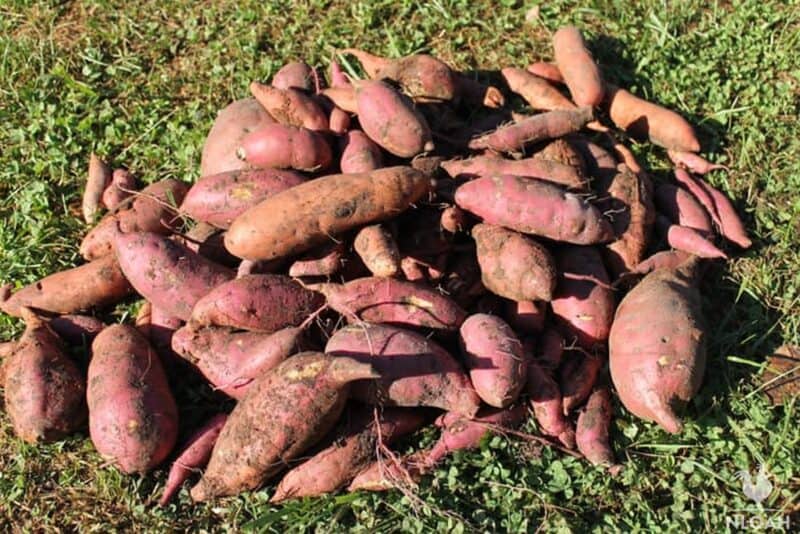
Sweet Potatoes
Believe it or not, sweet potatoes are easy to grow even if you don’t live in a warm environment. It’s all about knowing what you are doing.
Make sure your soil is loose and warm, and you’ll enjoy a bountiful harvest of sweet potatoes in the early fall.
Tomatoes
The tomato is the quintessential garden vegetable! Did you know that nine out of ten American household vegetable gardens have at least one tomato plant? The key to making tomato cultivation easy is to wait until you have the proper temperatures.
Tomatoes do very well as long as the soil temperature is between 65 and 80 degrees F (18 to 27 C). Otherwise, just make sure the soil is nice and fertile, and you’ll be good to go.
Cucumbers
Who doesn’t love the crunch of a good cucumber? These vegetables like lots of sunlight and warmth, and they may need a bit of support for climbing.
However, they do well in containers and in the ground. Give them enough water, and they’ll grow like weeds.
Brussel Sprouts
Like broccoli and carrots, Brussel sprouts like to grow during the colder portions of the growing season (early spring and late fall). Time your planting to match up with the climate in your area. That’s all you need to grow healthy, bountiful brussels sprouts!
It’s really easy to over-plant a garden area. Some seeds will do great, and others will require more tender loving care. Start small, and work your way up for garden size and space.
Plant the right types of plants for your gardening zone, and make sure that you’re planting them at the right depth, and spacing them far enough apart for them to thrive. Leave plenty of room between rows to get between them, and weed if you’re not using a weed cloth or something.
Herbs
Grandma had a garden just off the kitchen where she grew all sorts of herbs. She called this her potager garden, and in it she grew her herbs and seasonings. She would go out before preparing dinner and gather some that she would use that night.
It was also an ideal spot for an afternoon tea party and a good visit. She had a few benches that she had placed out in her garden and the pathway wound through the garden inviting you to come, sit, and rest a few.
Many of her herbs returned year after year. This was a great way to keep her herb garden going.
Here are some great herbs to grow in a potager garden for your cooking. You can also dry these for winter use by simply gathering them and hanging them upside down, or laying them on a tray to dry, and rotating them frequently.
Basil
Basil is virtually pest-resistant, which is why it’s one of the easiest herbs you can grow. As long as the weather is warm and sunny, you can grow this herb in just about any location.
It serves as a natural bug repellent, so it’s a smart plant to grow near your vegetables (particularly tomato plants).
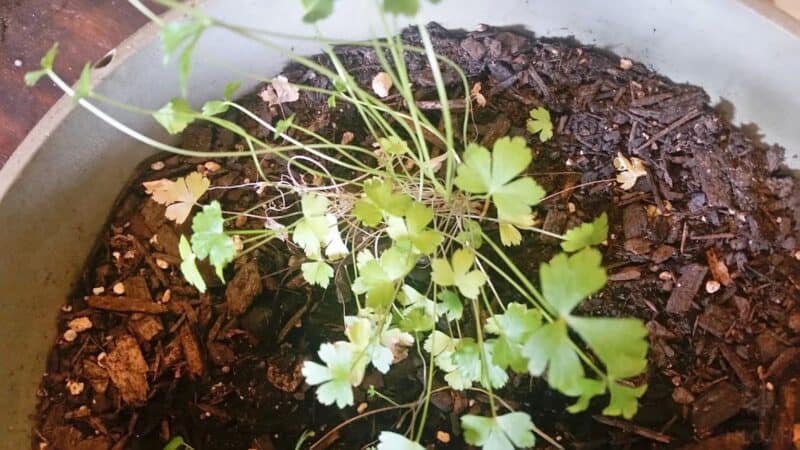
Parsley
Parsley is another easy to grow herb. Unlike basil, this herb does well in cooler temperatures (although full sun and well-draining are still preferred).
Garlic
Garlic is considered an herb by some people, and a vegetable by others. However you view it, it’s easy to grow. Plant in the fall, and you’ll enjoy a harvest during the early summer of the following year.
One of the beauties of growing garlic is that it can be cultivated at a time when other parts of the garden are lying dormant. You just need a bit of mulch to get it through the winter.
Store them in a clean glass jar with a lid after they’ve dried. Keep the glass jar in a dark location such as a cupboard, or even in the root cellar. This will prevent the herbs from degrading.
Herbs can also be gathered, tied together and hung upside down to dry in a greenhouse, or even in the kitchen. Not only can you simply snip some off for use while cooking, they can also lend a unique décor to your homestead.
Fruits/Berries
Depending on how much space you have, you may wish to consider the following fruits and berries for your homestead.
Keep in mind that most berry patches will spread over the next few years. Start small, and be sure you allow for plenty of room for growth.
Strawberries
Strawberries can be grown in any location and they produce early in the summer (usually, June). Once you plant a few strawberry plants, they’ll keep producing via underground stolons, too – you won’t know what to do with all the berries!
Raspberries / Blackberries
Both raspberries and blackberries are incredibly easy to grow on the homestead. Just make sure you have slightly acidic soil that’s fertile and well-draining, and your berry bushes will produce for many years.
Many homesteaders use their berries to make jams and jellies. They can also be used to make wine, juice, and you can freeze them to enjoy later. Mix and match them to create your own unique flavor treats.
Fruit Trees
Keep in mind that some varieties of fruit require two plants in order to properly pollinate. If you only plant one, you’re not going to get results. You’ll need two of the plant. There are many great guides on planting fruit trees successfully.
You’ll need to know your planting zone, and which varieties of fruit will work best for your region. Don’t forget space. If you don’t have a lot of space, you may also have to use dwarf fruit trees.
Apple
You’ll have to wait a few years to get any apples from your apple trees, but otherwise, they require little care – you might have to prune dead wood or branches occasionally.
Cherry
Like apple trees, cherry trees are the minimalist’s dream. They require very little work and will produce cherries for decades for you.
If you’re looking for areas of specific color on your homestead be sure that you select the right color varieties. Apples, for example, come in a variety of shades of reds, golds, bright yellows, and even green.
Crops
Some homesteaders have large scale crops such as the following. They either sell these or use the crops to feed their own animals on the homestead.
If you have the space you may wish to consider some of these options, however, keep in mind that you’ll also need to have the proper equipment to harvest and process these crops as well. If you don’t have the right equipment it may require a large investment and it may be better to consider other options.
Alfalfa
Alfalfa is the essential crop to grow if you are raising animals. Not only does it provide at on of nutrients to livestock, but it is great for the soil.
It provides nutrients directly to plant roots with its high nitrogen content, in fact. Plus, it can prevent compaction as it opens the soil up and acts like a sponge to prevent erosion.
Corn
Corn is really a multifunctional homestead plant. You can eat it, and so can your livestock! Consider growing a few rows of corn in your garden.
It requires minimal work and you can hoe around the plants to weed – so it won’t take you long at all.
Start Small
It’s easy to get caught up in planting more than you need or require on your homestead. The best advice is to start small, and stick to a few plants until you get them well established. Focus on your end goal, and don’t allow yourself to get carried away.
Start small and work your way up by adding a few more plants each year until you reach your desired results. It’s easy to look at a lovely magazine cover and tell yourself that you want your homestead to look just like that.
Keep in mind that it took years for that picture to evolve. It didn’t just happen in one season. For this reason, you’ll want to sit down with paper and pen and design your goals. Then, focus gradually on achieving those goals.
No two homesteads are alike and it’s important to keep this in mind when considering the summer plants to grow on your homestead. What works well for one homesteader may not work at all for another.
This could be due to the soil pH, the region or a combination thereof. You may not like some of the vegetables or fruits that your neighbors like, and that’s okay. Plant what you do like and enjoy it.
Make sure that you choose both perennial and annual plants, so you don’t have to replant the entire homestead each and every year.
Whether you choose to focus on functionality, or beauty, you can mix and match from the above-mentioned lists and design your summer plants on your homestead accordingly.
If you don’t like how it turns out one year, change it up for the next year until you come up with a design that you do like.
Your homestead is an extension of you, and you don’t have to follow any set rules or guidelines other than planting what makes you happy.
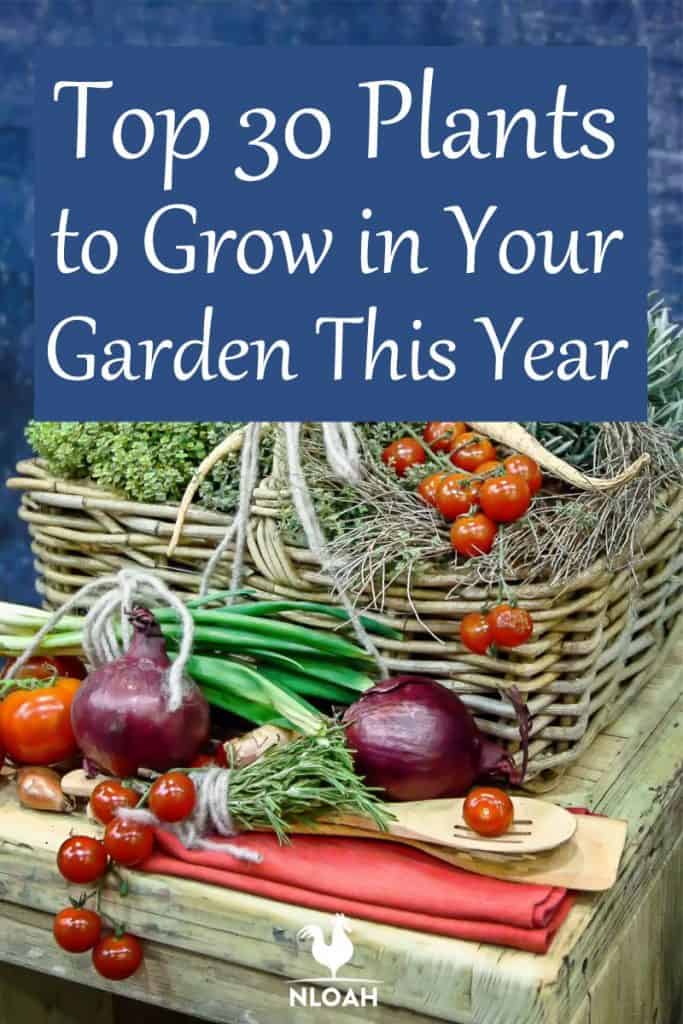

Hi, I’m Linda. I’m a mom, grandmother, homesteader. I love simple living and enjoy my life on a homestead where I garden, raise a variety of animals and strive for a life more like my grandparents lived.
My goal is to enrich life by living it as simply as possible and focusing on the way my grandparents did things. Life is so much more fun when it’s lived simply.
